Aristides Gionis
Fair Clustering for Data Summarization: Improved Approximation Algorithms and Complexity Insights
Oct 16, 2024Abstract:Data summarization tasks are often modeled as $k$-clustering problems, where the goal is to choose $k$ data points, called cluster centers, that best represent the dataset by minimizing a clustering objective. A popular objective is to minimize the maximum distance between any data point and its nearest center, which is formalized as the $k$-center problem. While in some applications all data points can be chosen as centers, in the general setting, centers must be chosen from a predefined subset of points, referred as facilities or suppliers; this is known as the $k$-supplier problem. In this work, we focus on fair data summarization modeled as the fair $k$-supplier problem, where data consists of several groups, and a minimum number of centers must be selected from each group while minimizing the $k$-supplier objective. The groups can be disjoint or overlapping, leading to two distinct problem variants each with different computational complexity. We present $3$-approximation algorithms for both variants, improving the previously known factor of $5$. For disjoint groups, our algorithm runs in polynomial time, while for overlapping groups, we present a fixed-parameter tractable algorithm, where the exponential runtime depends only on the number of groups and centers. We show that these approximation factors match the theoretical lower bounds, assuming standard complexity theory conjectures. Finally, using an open-source implementation, we demonstrate the scalability of our algorithms on large synthetic datasets and assess the price of fairness on real-world data, comparing solution quality with and without fairness constraints.
Relevance meets Diversity: A User-Centric Framework for Knowledge Exploration through Recommendations
Aug 07, 2024



Abstract:Providing recommendations that are both relevant and diverse is a key consideration of modern recommender systems. Optimizing both of these measures presents a fundamental trade-off, as higher diversity typically comes at the cost of relevance, resulting in lower user engagement. Existing recommendation algorithms try to resolve this trade-off by combining the two measures, relevance and diversity, into one aim and then seeking recommendations that optimize the combined objective, for a given number of items to recommend. Traditional approaches, however, do not consider the user interaction with the recommended items. In this paper, we put the user at the central stage, and build on the interplay between relevance, diversity, and user behavior. In contrast to applications where the goal is solely to maximize engagement, we focus on scenarios aiming at maximizing the total amount of knowledge encountered by the user. We use diversity as a surrogate of the amount of knowledge obtained by the user while interacting with the system, and we seek to maximize diversity. We propose a probabilistic user-behavior model in which users keep interacting with the recommender system as long as they receive relevant recommendations, but they may stop if the relevance of the recommended items drops. Thus, for a recommender system to achieve a high-diversity measure, it will need to produce recommendations that are both relevant and diverse. Finally, we propose a novel recommendation strategy that combines relevance and diversity by a copula function. We conduct an extensive evaluation of the proposed methodology over multiple datasets, and we show that our strategy outperforms several state-of-the-art competitors. Our implementation is publicly available at https://github.com/EricaCoppolillo/EXPLORE.
Efficient Exploration of the Rashomon Set of Rule Set Models
Jun 05, 2024Abstract:Today, as increasingly complex predictive models are developed, simple rule sets remain a crucial tool to obtain interpretable predictions and drive high-stakes decision making. However, a single rule set provides a partial representation of a learning task. An emerging paradigm in interpretable machine learning aims at exploring the Rashomon set of all models exhibiting near-optimal performance. Existing work on Rashomon-set exploration focuses on exhaustive search of the Rashomon set for particular classes of models, which can be a computationally challenging task. On the other hand, exhaustive enumeration leads to redundancy that often is not necessary, and a representative sample or an estimate of the size of the Rashomon set is sufficient for many applications. In this work, we propose, for the first time, efficient methods to explore the Rashomon set of rule set models with or without exhaustive search. Extensive experiments demonstrate the effectiveness of the proposed methods in a variety of scenarios.
Diversity-aware clustering: Computational Complexity and Approximation Algorithms
Jan 10, 2024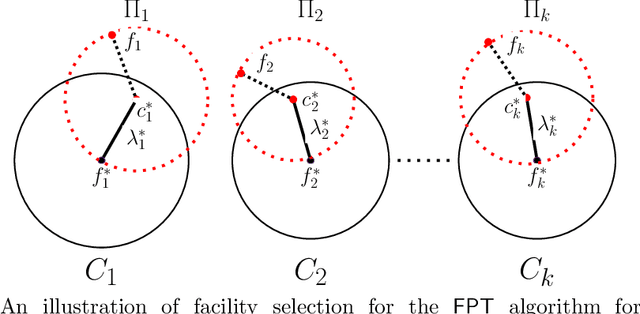
Abstract:In this work, we study diversity-aware clustering problems where the data points are associated with multiple attributes resulting in intersecting groups. A clustering solution need to ensure that a minimum number of cluster centers are chosen from each group while simultaneously minimizing the clustering objective, which can be either $k$-median, $k$-means or $k$-supplier. We present parameterized approximation algorithms with approximation ratios $1+ \frac{2}{e}$, $1+\frac{8}{e}$ and $3$ for diversity-aware $k$-median, diversity-aware $k$-means and diversity-aware $k$-supplier, respectively. The approximation ratios are tight assuming Gap-ETH and FPT $\neq$ W[2]. For fair $k$-median and fair $k$-means with disjoint faicility groups, we present parameterized approximation algorithm with approximation ratios $1+\frac{2}{e}$ and $1+\frac{8}{e}$, respectively. For fair $k$-supplier with disjoint facility groups, we present a polynomial-time approximation algorithm with factor $3$, improving the previous best known approximation ratio of factor $5$.
Rebalancing Social Feed to Minimize Polarization and Disagreement
Aug 28, 2023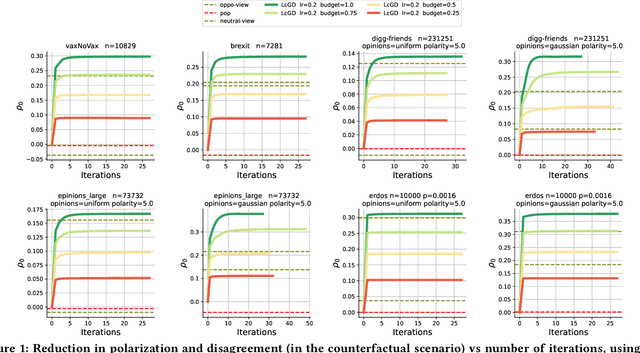
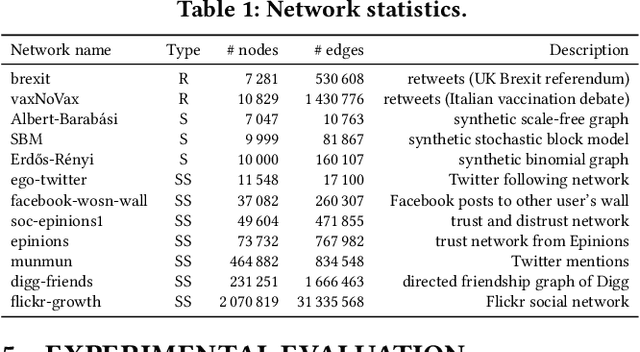
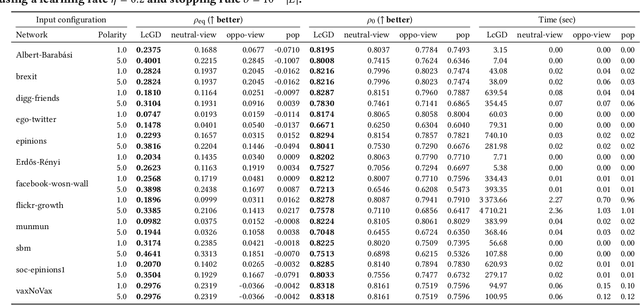

Abstract:Social media have great potential for enabling public discourse on important societal issues. However, adverse effects, such as polarization and echo chambers, greatly impact the benefits of social media and call for algorithms that mitigate these effects. In this paper, we propose a novel problem formulation aimed at slightly nudging users' social feeds in order to strike a balance between relevance and diversity, thus mitigating the emergence of polarization, without lowering the quality of the feed. Our approach is based on re-weighting the relative importance of the accounts that a user follows, so as to calibrate the frequency with which the content produced by various accounts is shown to the user. We analyze the convexity properties of the problem, demonstrating the non-matrix convexity of the objective function and the convexity of the feasible set. To efficiently address the problem, we develop a scalable algorithm based on projected gradient descent. We also prove that our problem statement is a proper generalization of the undirected-case problem so that our method can also be adopted for undirected social networks. As a baseline for comparison in the undirected case, we develop a semidefinite programming approach, which provides the optimal solution. Through extensive experiments on synthetic and real-world datasets, we validate the effectiveness of our approach, which outperforms non-trivial baselines, underscoring its ability to foster healthier and more cohesive online communities.
Adversaries with Limited Information in the Friedkin--Johnsen Model
Jun 17, 2023Abstract:In recent years, online social networks have been the target of adversaries who seek to introduce discord into societies, to undermine democracies and to destabilize communities. Often the goal is not to favor a certain side of a conflict but to increase disagreement and polarization. To get a mathematical understanding of such attacks, researchers use opinion-formation models from sociology, such as the Friedkin--Johnsen model, and formally study how much discord the adversary can produce when altering the opinions for only a small set of users. In this line of work, it is commonly assumed that the adversary has full knowledge about the network topology and the opinions of all users. However, the latter assumption is often unrealistic in practice, where user opinions are not available or simply difficult to estimate accurately. To address this concern, we raise the following question: Can an attacker sow discord in a social network, even when only the network topology is known? We answer this question affirmatively. We present approximation algorithms for detecting a small set of users who are highly influential for the disagreement and polarization in the network. We show that when the adversary radicalizes these users and if the initial disagreement/polarization in the network is not very high, then our method gives a constant-factor approximation on the setting when the user opinions are known. To find the set of influential users, we provide a novel approximation algorithm for a variant of MaxCut in graphs with positive and negative edge weights. We experimentally evaluate our methods, which have access only to the network topology, and we find that they have similar performance as methods that have access to the network topology and all user opinions. We further present an NP-hardness proof, which was an open question by Chen and Racz [IEEE Trans. Netw. Sci. Eng., 2021].
Learning Cellular Coverage from Real Network Configurations using GNNs
Apr 20, 2023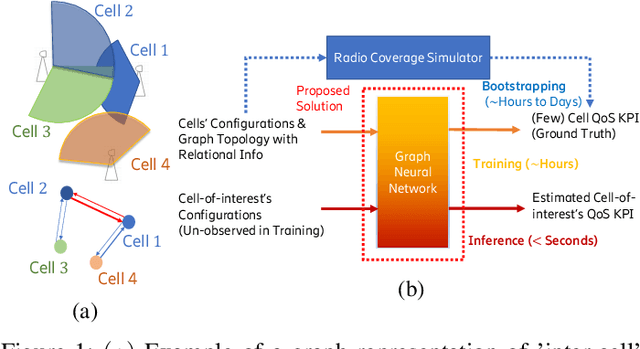
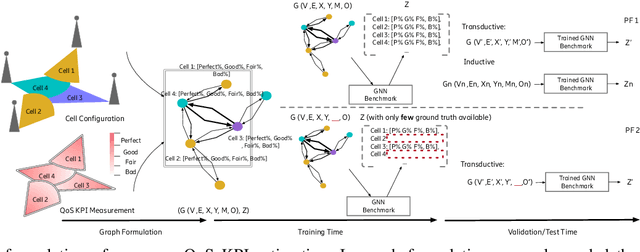
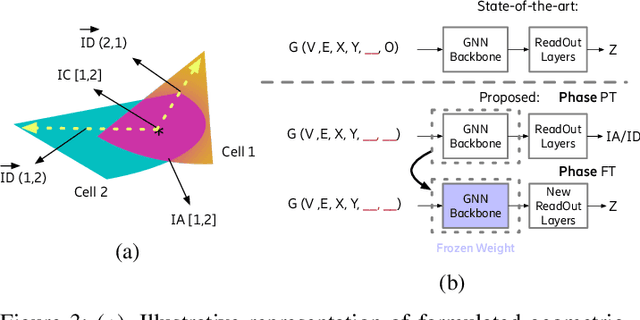
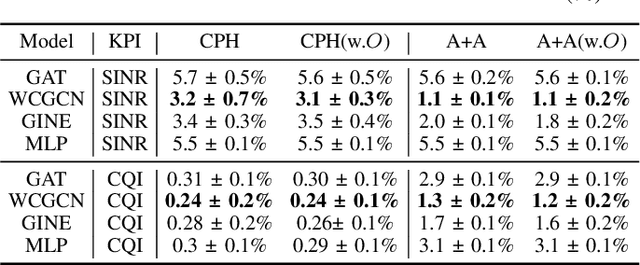
Abstract:Cellular coverage quality estimation has been a critical task for self-organized networks. In real-world scenarios, deep-learning-powered coverage quality estimation methods cannot scale up to large areas due to little ground truth can be provided during network design & optimization. In addition they fall short in produce expressive embeddings to adequately capture the variations of the cells' configurations. To deal with this challenge, we formulate the task in a graph representation and so that we can apply state-of-the-art graph neural networks, that show exemplary performance. We propose a novel training framework that can both produce quality cell configuration embeddings for estimating multiple KPIs, while we show it is capable of generalising to large (area-wide) scenarios given very few labeled cells. We show that our framework yields comparable accuracy with models that have been trained using massively labeled samples.
Concise and interpretable multi-label rule sets
Oct 04, 2022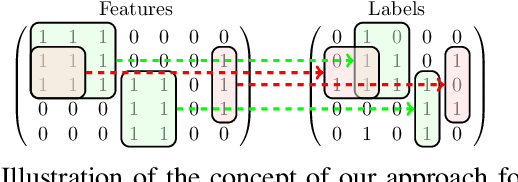
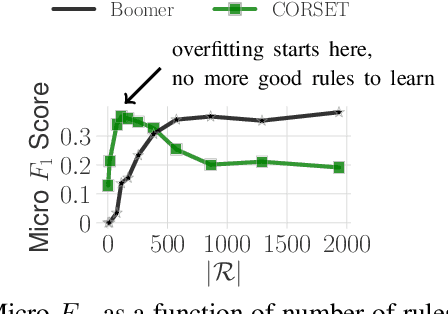
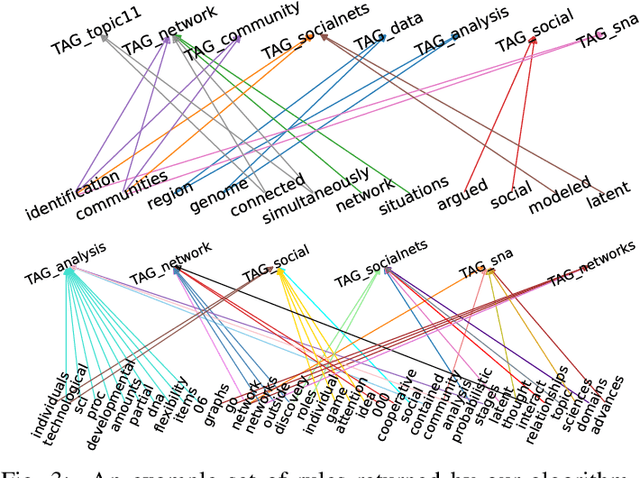
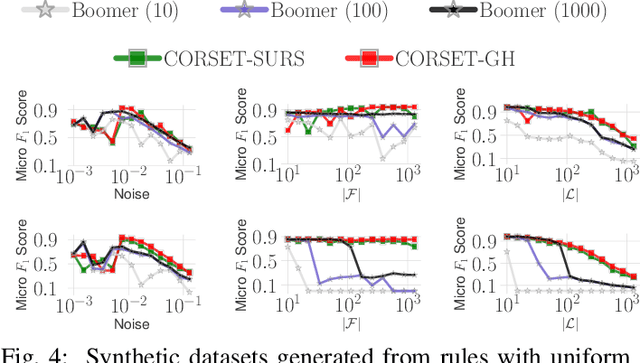
Abstract:Multi-label classification is becoming increasingly ubiquitous, but not much attention has been paid to interpretability. In this paper, we develop a multi-label classifier that can be represented as a concise set of simple "if-then" rules, and thus, it offers better interpretability compared to black-box models. Notably, our method is able to find a small set of relevant patterns that lead to accurate multi-label classification, while existing rule-based classifiers are myopic and wasteful in searching rules,requiring a large number of rules to achieve high accuracy. In particular, we formulate the problem of choosing multi-label rules to maximize a target function, which considers not only discrimination ability with respect to labels, but also diversity. Accounting for diversity helps to avoid redundancy, and thus, to control the number of rules in the solution set. To tackle the said maximization problem we propose a 2-approximation algorithm, which relies on a novel technique to sample high-quality rules. In addition to our theoretical analysis, we provide a thorough experimental evaluation, which indicates that our approach offers a trade-off between predictive performance and interpretability that is unmatched in previous work.
Regularized impurity reduction: Accurate decision trees with complexity guarantees
Aug 23, 2022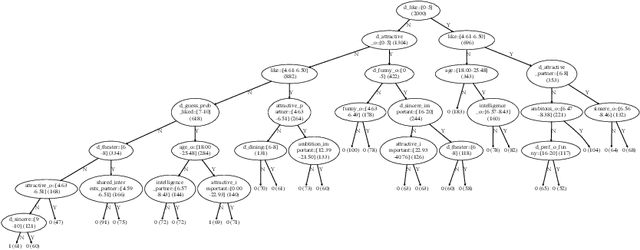
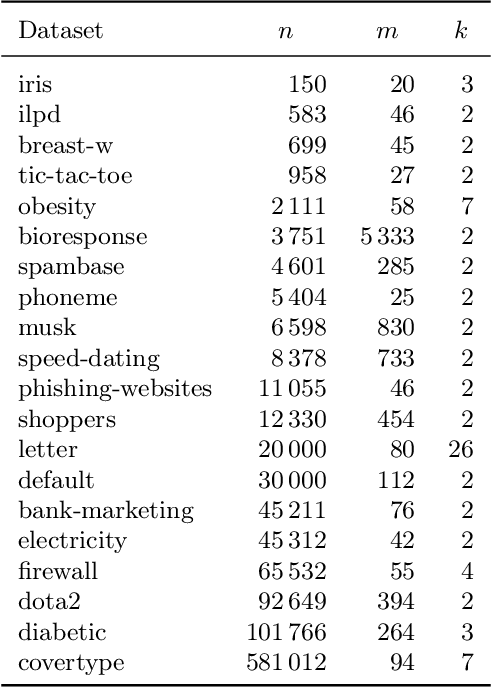


Abstract:Decision trees are popular classification models, providing high accuracy and intuitive explanations. However, as the tree size grows the model interpretability deteriorates. Traditional tree-induction algorithms, such as C4.5 and CART, rely on impurity-reduction functions that promote the discriminative power of each split. Thus, although these traditional methods are accurate in practice, there has been no theoretical guarantee that they will produce small trees. In this paper, we justify the use of a general family of impurity functions, including the popular functions of entropy and Gini-index, in scenarios where small trees are desirable, by showing that a simple enhancement can equip them with complexity guarantees. We consider a general setting, where objects to be classified are drawn from an arbitrary probability distribution, classification can be binary or multi-class, and splitting tests are associated with non-uniform costs. As a measure of tree complexity, we adopt the expected cost to classify an object drawn from the input distribution, which, in the uniform-cost case, is the expected number of tests. We propose a tree-induction algorithm that gives a logarithmic approximation guarantee on the tree complexity. This approximation factor is tight up to a constant factor under mild assumptions. The algorithm recursively selects a test that maximizes a greedy criterion defined as a weighted sum of three components. The first two components encourage the selection of tests that improve the balance and the cost-efficiency of the tree, respectively, while the third impurity-reduction component encourages the selection of more discriminative tests. As shown in our empirical evaluation, compared to the original heuristics, the enhanced algorithms strike an excellent balance between predictive accuracy and tree complexity.
Generalized Leverage Scores: Geometric Interpretation and Applications
Jun 16, 2022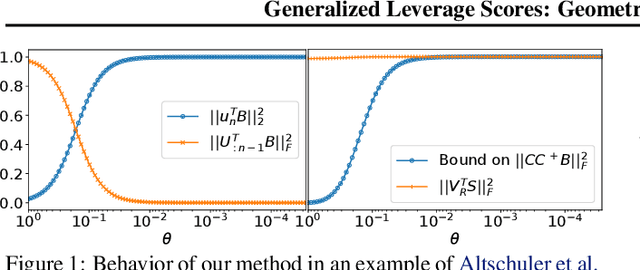


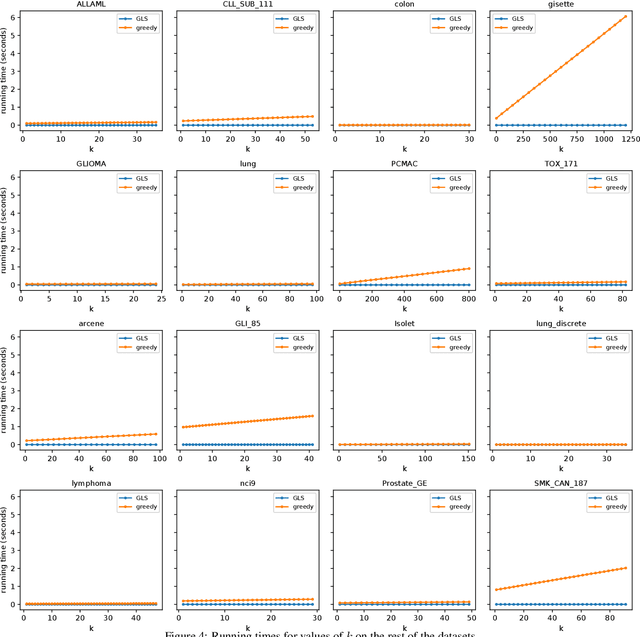
Abstract:In problems involving matrix computations, the concept of leverage has found a large number of applications. In particular, leverage scores, which relate the columns of a matrix to the subspaces spanned by its leading singular vectors, are helpful in revealing column subsets to approximately factorize a matrix with quality guarantees. As such, they provide a solid foundation for a variety of machine-learning methods. In this paper we extend the definition of leverage scores to relate the columns of a matrix to arbitrary subsets of singular vectors. We establish a precise connection between column and singular-vector subsets, by relating the concepts of leverage scores and principal angles between subspaces. We employ this result to design approximation algorithms with provable guarantees for two well-known problems: generalized column subset selection and sparse canonical correlation analysis. We run numerical experiments to provide further insight on the proposed methods. The novel bounds we derive improve our understanding of fundamental concepts in matrix approximations. In addition, our insights may serve as building blocks for further contributions.
 Add to Chrome
Add to Chrome Add to Firefox
Add to Firefox Add to Edge
Add to Edge